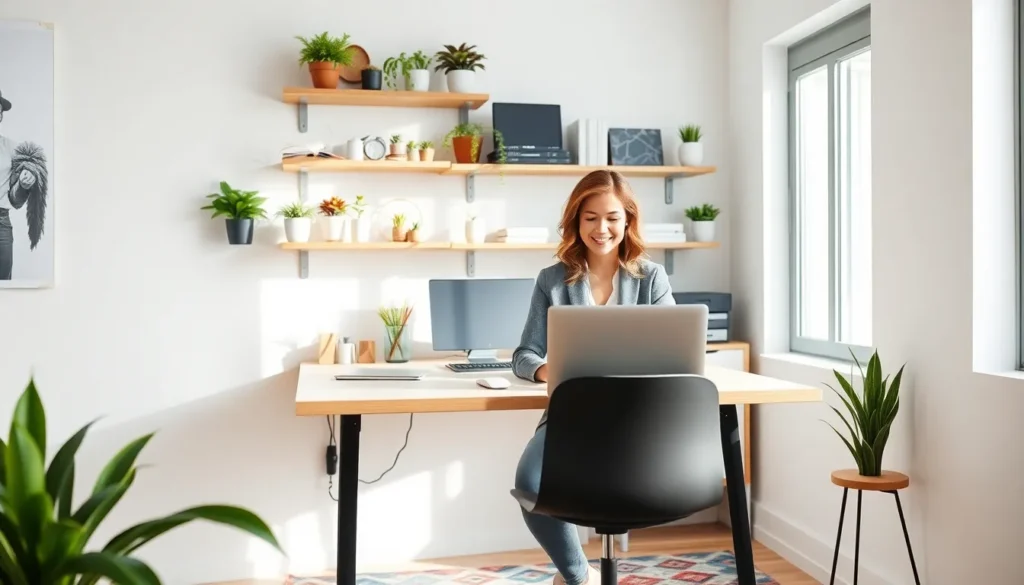We’ve all been there – staring at a cramped corner or spare room wondering how we’ll ever transform it into a productive workspace. Tiny office spaces don’t have to mean sacrificing functionality or style. With the right approach, even the smallest areas can become powerful productivity hubs that rival any corporate office.
The secret lies in maximizing every square inch through smart design choices and creative answers. We’re talking about vertical storage systems, multi-functional furniture, and clever layouts that make your space feel twice as large. Whether you’re working with a closet-sized nook or a narrow hallway, there’s always a way to create an efficient workspace.
Ready to discover how top designers and productivity experts tackle space constraints? We’ll show you proven strategies that’ll transform your tiny area into an organized, inspiring office that actually makes you want to work. Let’s turn that space challenge into your biggest advantage.
Maximize Vertical Wall Space With Floating Shelves and Storage
Vertical wall space becomes your most valuable asset when floor space is limited. We’ll show you how to transform bare walls into organized storage powerhouses that keep your tiny office functional and clutter-free.
Install Floor-to-Ceiling Shelving Units
Floor-to-ceiling shelving units create dramatic storage capacity while drawing the eye upward to make rooms feel larger. We recommend installing adjustable shelving systems that can accommodate everything from books and binders to decorative storage boxes and office supplies.
IKEA’s IVAR system offers customizable wooden shelves starting at $80 per unit, while CB2’s stairway wall mounted bookcase provides a sleek modern alternative for $299. Position heavier items on lower shelves and lighter decorative pieces near the top to maintain visual balance.
Consider these placement strategies for maximum impact:
- Place frequently used items at eye level for easy access
- Store seasonal documents and supplies on the highest shelves
- Display a few plants or decorative objects to break up the utilitarian look
- Group similar items together using matching storage containers
Use Wall-Mounted Desk Answers
Wall-mounted desks eliminate the need for bulky furniture legs while providing essential workspace in the smallest areas. We’ve found that floating desks work particularly well in corners or alongside existing furniture pieces.
The UPLIFT V2 wall-mounted standing desk adjusts from 25.3″ to 50.9″ in height and supports up to 200 pounds, making it perfect for dual monitor setups. West Elm’s mid-century wall desk offers a more compact solution at 42″ wide with built-in storage compartments.
Mount your desk at the proper height for your chair:
- Standard sitting height ranges from 28″ to 30″ from floor to desktop
- Standing desk height should align with your elbows at 90-degree angles
- Dual-height options accommodate both sitting and standing work positions
- Cable management systems keep power cords organized and hidden
Add Pegboards for Organizational Tools
Pegboards provide flexible storage that adapts to your changing organizational needs without permanent modifications. We love how these systems let you customize hook and shelf placement while keeping essential tools within arm’s reach.
The Container Store’s elfa utility pegboard system starts at $39 for a 24″ x 36″ board and includes various hooks, shelves, and containers. IKEA’s SKÅDIS pegboard offers a budget-friendly option at $15 with coordinating accessories ranging from $2 to $25.
- Hang scissors, tape dispensers, and hole punches on individual hooks
- Mount small baskets for pens, paper clips, and rubber bands
- Attach magnetic strips to hold metal tools and supplies
- Include a small shelf for your phone, coffee mug, or small plants
Choose Multi-Functional Furniture That Serves Double Duty
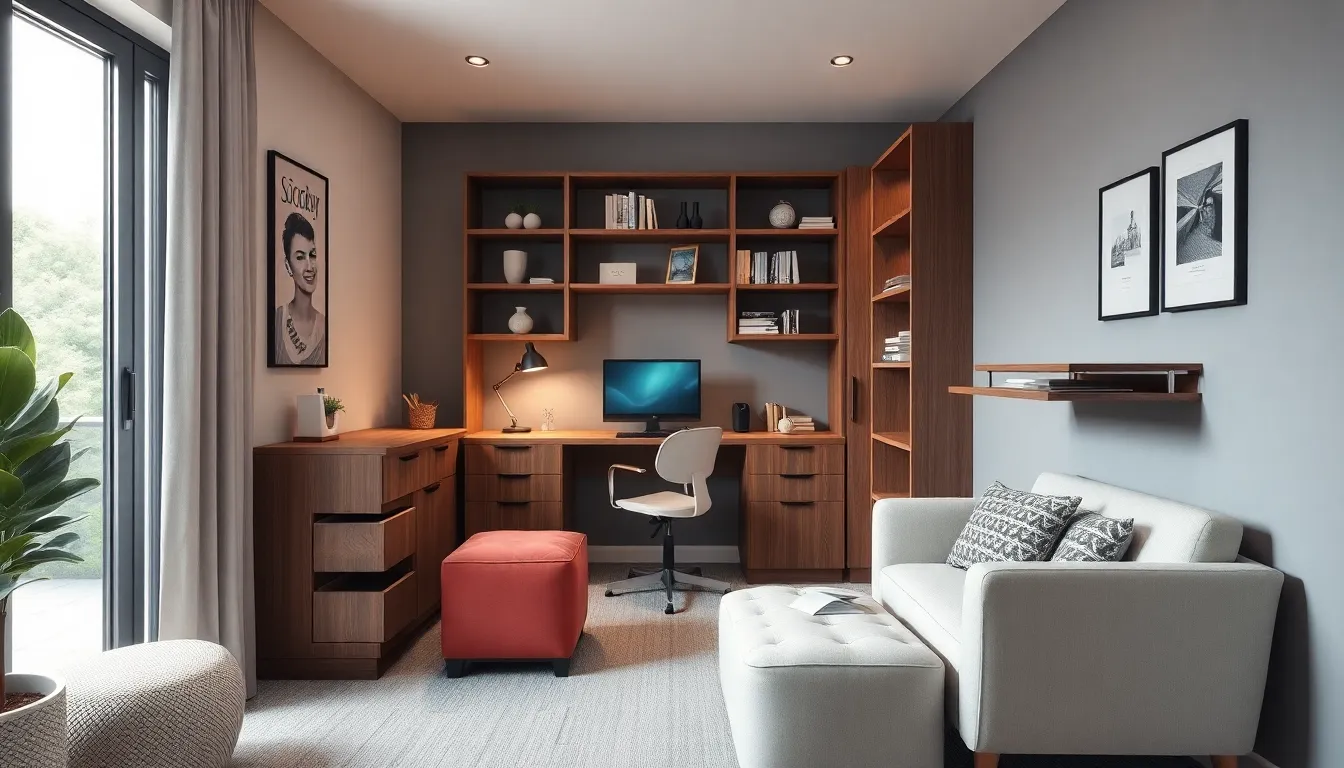
Smart furniture selection transforms cramped quarters into functional workspaces by combining essential office elements into single pieces. We’ve found that dual-purpose furniture pieces maximize efficiency while minimizing your spatial footprint.
Select Desks With Built-In Storage Drawers
Desk drawer combinations eliminate the need for separate filing cabinets while providing immediate access to important documents and supplies. These integrated storage answers keep your workspace organized without requiring additional floor space for standalone storage units.
Choose desks featuring multiple drawer sizes to accommodate everything from small office supplies like paper clips and pens to larger items such as binders and tech accessories. Popular options include secretary desks with fold-down writing surfaces and computer desks with keyboard trays and CPU storage compartments.
Position frequently used items in the top drawers while storing less essential materials in lower compartments. This strategic organization keeps your most important tools within arm’s reach during busy workdays.
Use Storage Ottomans as Seating and Filing
Storage ottomans serve as comfortable seating options while concealing office supplies, documents, or equipment inside their hollow interiors. We recommend selecting ottomans with removable lids for easy access to stored materials.
Place these versatile pieces near your desk to create additional seating for clients or colleagues while maintaining quick access to files and supplies. Ottoman storage works particularly well for seasonal documents, backup equipment, or presentation materials you don’t need daily.
Choose ottomans with sturdy construction that can support both weight and frequent opening. Fabric options blend seamlessly with home office decor, while leather versions offer professional appeal for client meetings.
Opt for Fold-Down Desk Tables
Fold down desks attach directly to walls and disappear completely when not in use, making them perfect for shared spaces or rooms with multiple functions. These space-saving answers provide full-sized work surfaces that fold flat against the wall.
Install fold down tables at standard desk height (approximately 29-30 inches) to ensure comfortable typing and writing positions. Many models include built-in cable management systems to keep cords organized when the desk is in use.
Consider wall-mounted fold down desks with integrated shelving that combines workspace with storage in a single compact unit. These combination pieces offer the functionality of traditional desks while occupying zero floor space when folded up.
Create Zones Using Room Dividers and Visual Separation
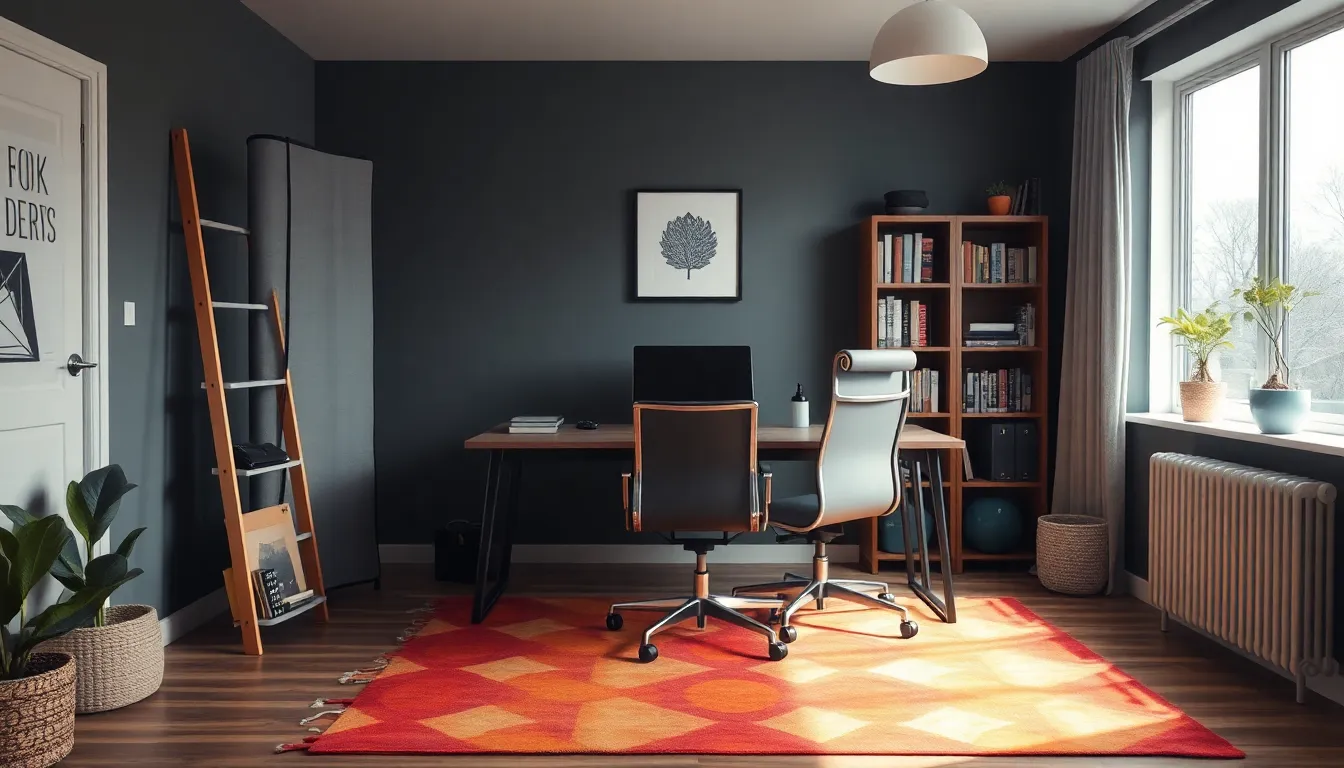
Smart zoning transforms even the tiniest office spaces into organized, functional environments. We’ll show you how to create distinct areas without sacrificing precious square footage.
Install Privacy Screens for Focus Areas
Privacy screens create instant focus zones in open-plan tiny offices, helping minimize distractions while maintaining visual flow. We recommend portable screens that move easily between different work areas throughout the day. Acoustic panels work double duty by reducing noise levels and providing visual separation from high-traffic areas.
Folding screens offer the most flexibility for changing needs, allowing you to reconfigure your workspace layout as projects evolve. Desktop privacy panels attach directly to existing work surfaces, creating personal boundaries without requiring floor space. Translucent materials like frosted acrylic maintain natural light flow while still providing the psychological benefits of separation.
Use Bookcases as Natural Room Dividers
Bookcases serve as perfect room dividers that maximize storage while creating distinct zones within cramped quarters. We suggest choosing open-back units that allow light to pass through, preventing the space from feeling closed off. Ladder-style bookcases take up minimal floor space while providing vertical storage that reaches toward the ceiling.
Floating bookshelf systems create the illusion of separation without heavy visual weight that might overwhelm small spaces. Modular cube organizers let you customize height and configuration based on your exact zoning needs. Two-sided bookcases work particularly well as dividers since they provide storage access from both sides of the partition.
Define Spaces With Area Rugs
Area rugs create invisible boundaries that help define different work zones without physical barriers or construction. We place larger rugs under primary work areas to anchor desk spaces and smaller accent rugs to highlight secondary zones like reading corners. Contrasting textures between different rug areas help the eye distinguish separate functions within the same room.
Color coordination between rugs maintains visual cohesion while still creating distinct spaces for various office activities. Sound-absorbing rugs reduce noise transfer between zones, making phone calls and video conferences more professional. Runner rugs work especially well in narrow offices to create pathways that guide movement between different work areas.
Utilize Under-Stair Areas and Awkward Corners
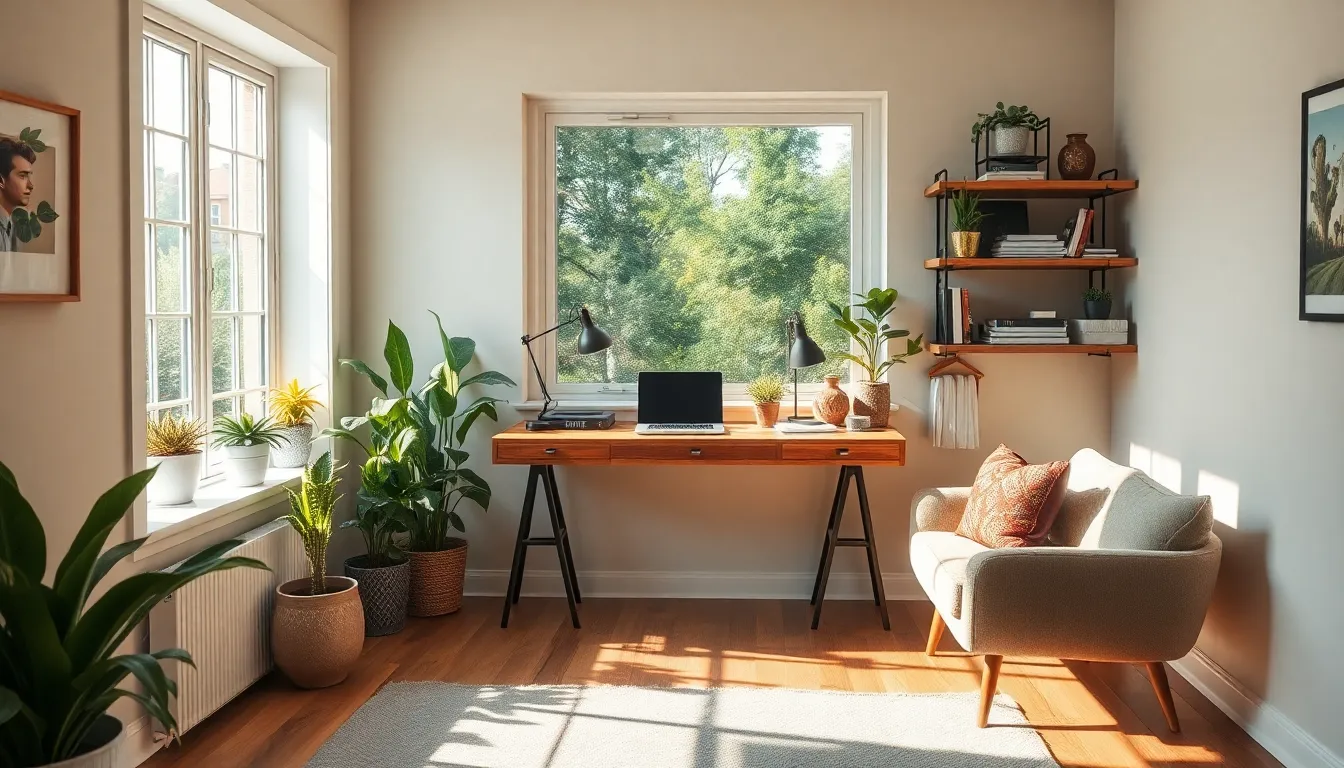
Forgotten corners and underutilized spaces in our homes present excellent opportunities for creating functional workstations. We’ll explore how these overlooked areas can become productive office zones that maximize every square foot.
Transform Staircase Nooks Into Workstations
Staircase nooks offer unique design opportunities that combine privacy with efficiency. We recommend installing custom desks customized to fit these irregular shapes, maximizing both vertical and horizontal space for productivity. Built-in storage answers work particularly well in these areas, allowing us to incorporate drawers and shelving that follow the stair’s natural angle.
Task lighting becomes essential in these typically darker spaces. Install LED strip lights under shelves or add a sleek desk lamp to create proper illumination for focused work. Privacy screens or curtains can further define the space, creating a dedicated office area that feels separate from high-traffic stair zones.
Landing areas along staircases also present workstation possibilities. Position a narrow console desk against the wall, add floating shelves above, and incorporate a comfortable chair that doesn’t obstruct foot traffic. This approach creates a secondary workspace perfect for quick tasks or phone calls.
Convert Closets Into Mini Home Offices
Closet offices, known as “cloffices,” transform unused storage into dedicated workspaces. Remove closet doors to open up the space, then install a wall-mounted or built-in desk that spans the width of the opening. This configuration provides a surprising amount of work surface while maintaining the room’s original footprint.
Lighting installation becomes crucial since closets typically lack natural illumination. We suggest adding overhead LED fixtures or track lighting to brighten the entire space. Task lighting at desk level ensures comfortable working conditions throughout the day.
Organization systems maximize these compact areas effectively. Use the existing closet rod for hanging file folders or install shelving units along the walls. Baskets and bins keep supplies organized while maintaining visual appeal. When work’s complete, simply pull a curtain or sliding door across the opening to hide the office space.
Make Use of Bay Window Alcoves
Bay window alcoves provide natural light and inspiring views, creating ideal conditions for productive work. Position a desk across the bay window to use the recessed area efficiently, taking advantage of the extra square footage these architectural features provide. The natural light reduces eye strain and creates an energizing work environment.
Custom desk answers work best in these spaces since bay windows vary in size and shape. Consider a built-in desk that follows the window’s curve, or use a standard desk with side tables to fill the entire alcove. Adding comfortable seating transforms the area into a pleasant workspace that encourages longer work sessions.
Window treatments balance privacy needs with natural light benefits. Adjustable blinds or sheer curtains allow us to control glare while maintaining views. Plants placed on the windowsill or nearby surfaces enhance the connection to nature, creating a more inspiring and relaxing work environment.
Storage answers in bay window offices require creative thinking. Floating shelves on adjacent walls provide book and supply storage without blocking window light. Under-desk drawers or a rolling cart offer additional organization options that can be moved when cleaning or rearranging the space.
Implement Smart Lighting Solutions for Small Spaces
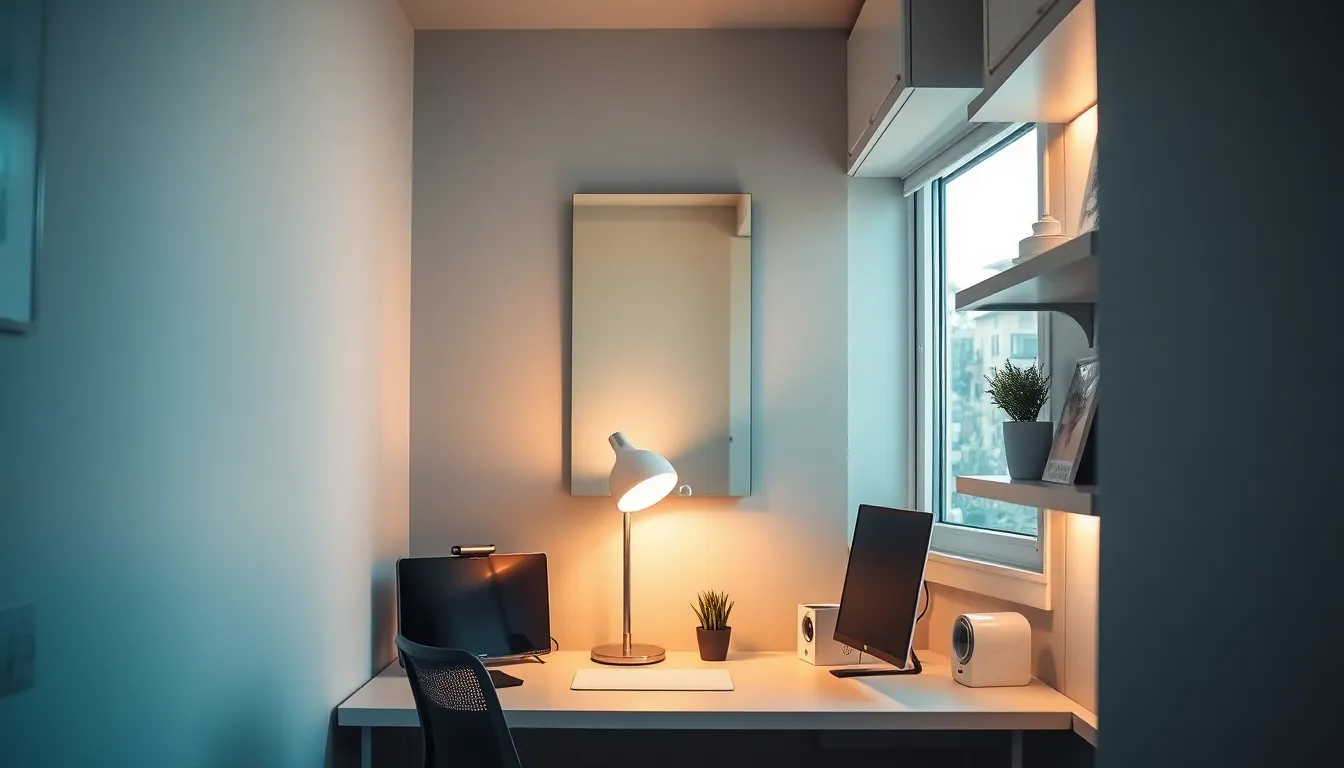
Poor lighting can make even the most well-organized tiny office feel cramped and unwelcoming. We’ll show you how strategic lighting choices transform compact workspaces into bright, productive environments.
Add Task Lighting With LED Desk Lamps
LED desk lamps provide focused illumination exactly where we need it most, reducing eye strain during long work sessions. These energy-efficient fixtures consume up to 80% less electricity than traditional incandescent bulbs while delivering superior brightness quality.
Adjustable LED lamps offer multiple positioning options, allowing us to direct light precisely onto documents, keyboards, or drawing surfaces. Modern designs include dimming controls and color temperature settings, letting us customize the lighting for different tasks throughout the day.
Clamp-on LED models work perfectly for tiny offices because they don’t require valuable desk surface space. We can attach these versatile lamps to shelves, monitor arms, or desk edges, keeping our limited workspace clear while maintaining optimal task lighting.
Use Natural Light With Strategic Mirror Placement
Mirrors amplify existing natural light, making small office spaces feel significantly larger and brighter without additional electrical fixtures. Positioning a mirror directly opposite a window doubles the amount of natural light entering the room through reflection.
Large wall mirrors create the illusion of expanded space while maximizing daylight distribution throughout our tiny office. We recommend placing mirrors at angles that capture morning or afternoon sunlight, depending on our window orientation and peak working hours.
Smaller decorative mirrors can redirect light into darker corners where traditional overhead lighting falls short. Strategic placement near workstations ensures we benefit from natural illumination during critical tasks, reducing our dependence on artificial lighting during daytime hours.
Install Under-Cabinet LED Strip Lighting
LED strip lighting delivers ambient illumination without consuming any floor or desk space in our cramped office quarters. These thin, flexible strips easily mount beneath floating shelves, wall-mounted desks, or storage cabinets for seamless integration.
Battery-powered LED strips offer installation flexibility in areas without nearby electrical outlets, perfect for rental spaces where permanent wiring isn’t possible. Remote-controlled options let us adjust brightness and activate lighting without reaching into tight spaces or disrupting our workflow.
Warm white LED strips create inviting atmosphere while cool white versions enhance focus and productivity during detailed work sessions. We can layer multiple strips at different heights to eliminate harsh shadows and create even light distribution throughout our compact workspace.
Organize With Compact Storage Systems and Solutions
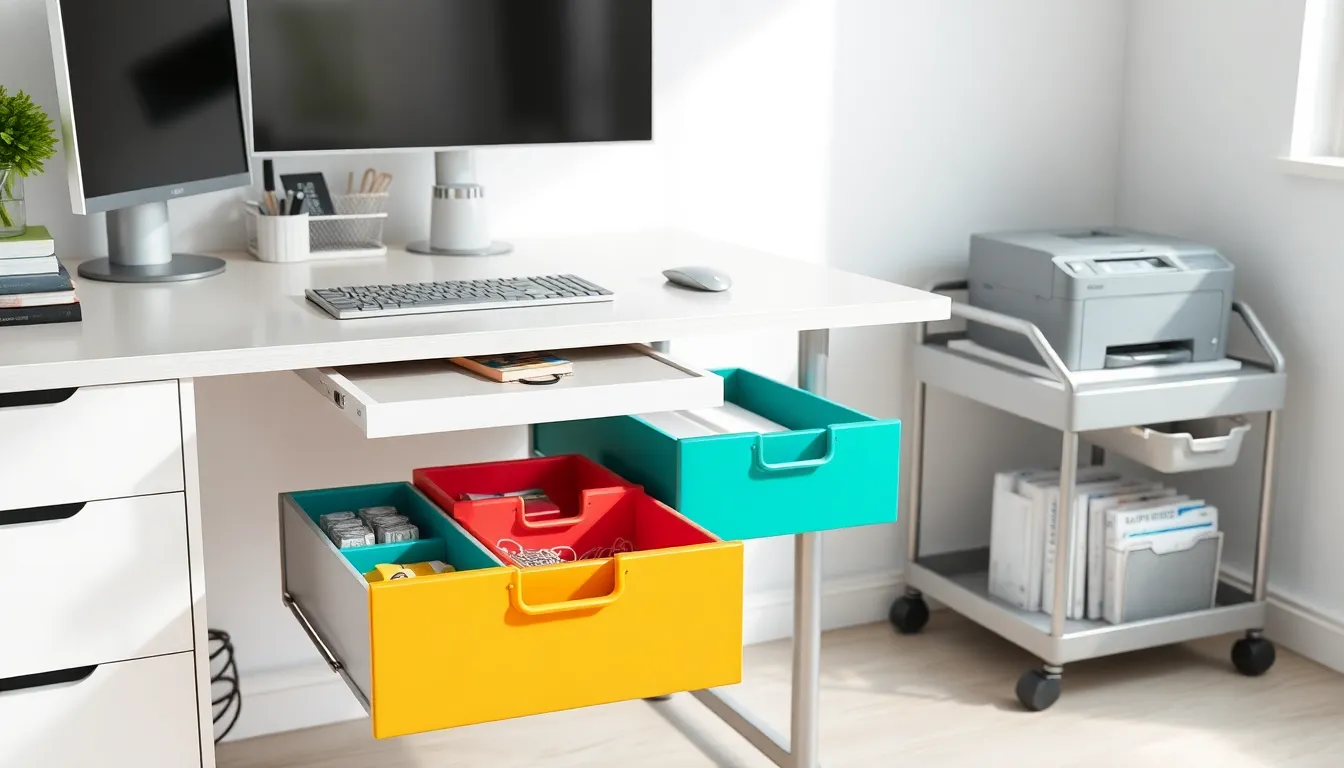
We can transform even the smallest office spaces into highly organized workstations with the right storage strategies. Smart storage answers help maximize every inch while keeping essential items within easy reach.
Use Drawer Organizers for Small Office Supplies
Drawer dividers create designated spaces for each office supply category, preventing the chaos that typically builds up in desk drawers. We recommend using adjustable dividers that can be customized to fit various item sizes, from paper clips to staplers and sticky notes.
Labeling each compartment ensures everything returns to its proper place after use. Small items like thumbtacks, rubber bands, and binder clips stay visible and accessible when separated into individual sections. This system eliminates the frustrating search through cluttered drawers and maintains long term organization.
Install Pull-Out Keyboard Trays
Pull-out keyboard trays free up valuable desk surface area while creating a more ergonomic workspace. These trays slide smoothly under the desk when not in use, giving us additional room for documents, notebooks, or decorative items on the main work surface.
Ergonomic benefits include better wrist positioning and reduced strain during long typing sessions. Modern keyboard trays accommodate both keyboards and mice, with some models featuring adjustable heights and tilt angles. Installation typically requires basic tools and can be completed in under 30 minutes for most desk styles.
Add Rolling Carts for Mobile Storage
Rolling carts provide flexible storage that moves wherever we need it most in our compact office space. These versatile units can hold printers, paper supplies, reference books, and frequently used office equipment while keeping our main desk area clear and uncluttered.
Space efficiency improves dramatically when we can wheel storage away from high traffic areas during meetings or video calls. Multi tiered carts maximize vertical storage capacity, with some models featuring up to four shelves in a compact footprint. The mobility factor allows us to reconfigure our workspace layout as needed throughout the day.
Design With Light Colors and Minimalist Aesthetics
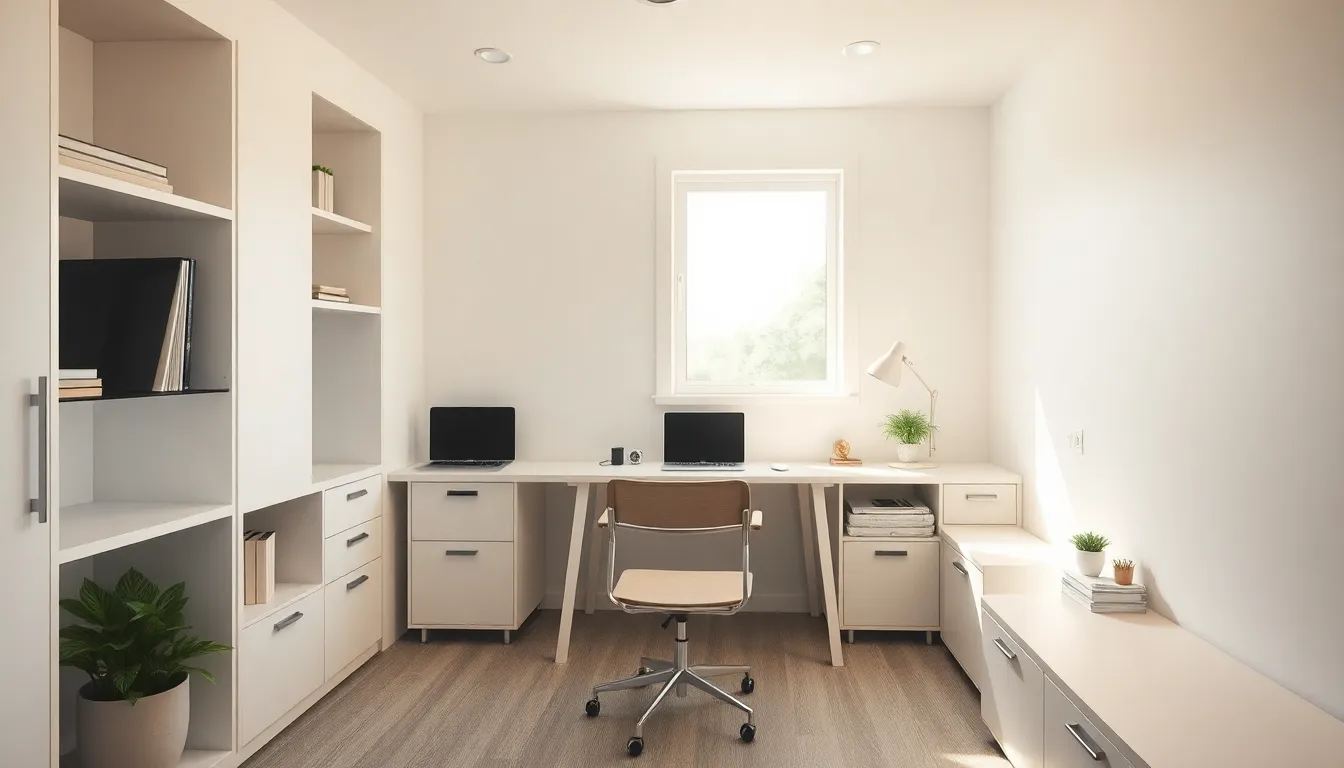
Light colors and clean design principles can transform even the tiniest office space into an airy and spacious environment. We’ll explore how strategic color choices and minimalist approaches maximize both visual space and functionality.
Choose White and Neutral Color Palettes
White and neutral color palettes instantly make small spaces appear larger and more spacious by reflecting available light throughout the room. We recommend using pure white as your primary wall color, which creates a clean backdrop that visually expands boundaries. Soft beiges, warm grays, and cream tones work beautifully as accent colors on furniture and accessories.
Natural light reflection becomes significantly more effective when we incorporate these lighter tones across all surfaces. Paint your ceiling white to create the illusion of height, while keeping trim and moldings in matching neutral shades. We suggest using the same light color family throughout adjacent areas to create visual flow and eliminate jarring transitions that can make spaces feel choppy.
Select Streamlined Furniture With Clean Lines
Streamlined furniture with simple, clean lines maintains our minimalist aesthetic while avoiding visual clutter that overwhelms tiny spaces. We choose pieces with straight edges and geometric shapes rather than ornate or curved designs that can feel heavy in compact areas. Sleek desks with thin legs and minimal hardware create an open feeling beneath the work surface.
Furniture proportions should remain appropriate to your space size, with lower profile pieces helping rooms feel taller. We recommend selecting items with exposed legs that allow light to flow underneath, creating the illusion of more floor space. Built in storage features eliminate the need for additional furniture pieces while maintaining those clean lines we’re after.
Minimize Visual Clutter With Hidden Storage
Hidden storage answers keep office supplies completely out of sight while maintaining our clutter free environment throughout the workspace. We install built in shelves behind cabinet doors or inside desk drawers to organize essential items without creating visual distractions. Under desk filing systems slide completely out of view when we’re not accessing documents.
Wall mounted storage cabinets with flush front panels blend seamlessly into our neutral color scheme while providing ample space for supplies. We use drawer organizers with adjustable dividers to keep small items categorized and prevent drawers from becoming messy catch alls. Cable management systems hide unsightly cords behind furniture or inside cord channels that maintain our clean aesthetic.
Incorporate Technology to Reduce Physical Clutter
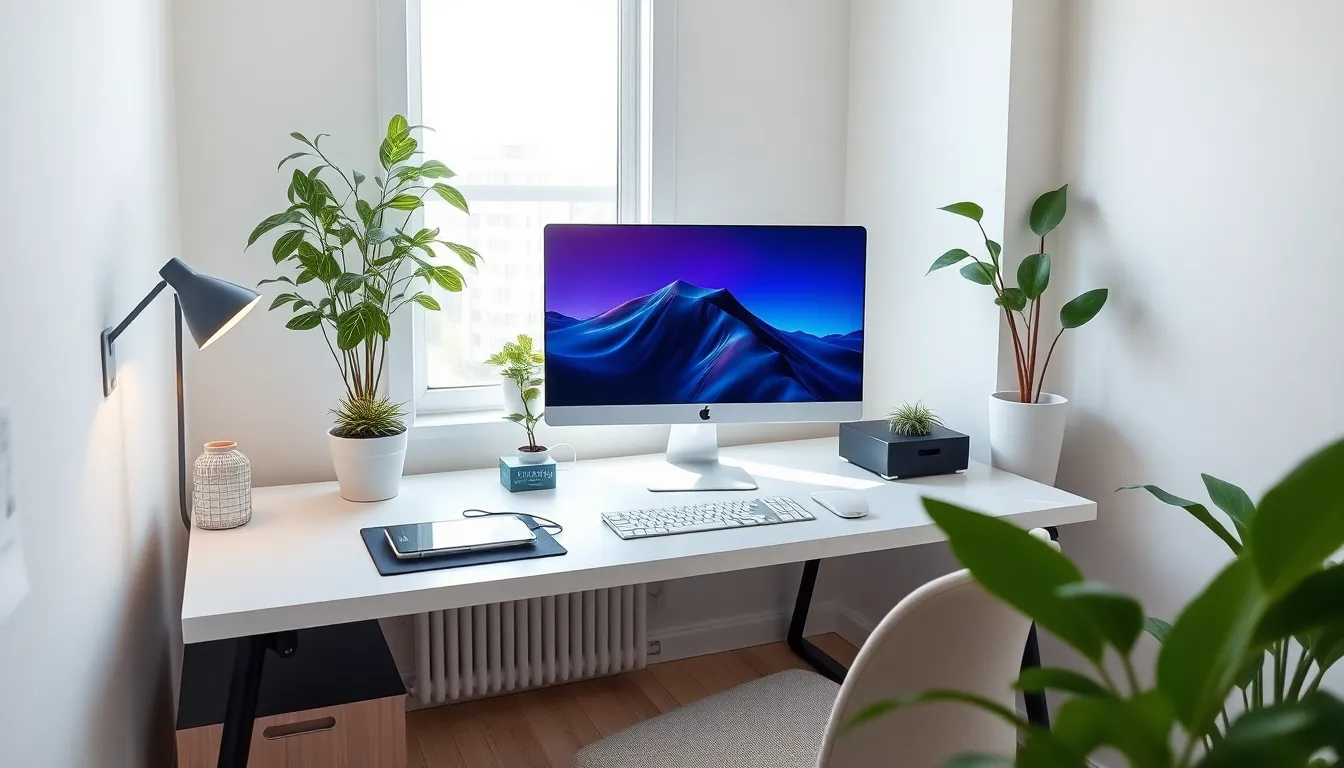
Digital answers can transform your compact workspace by eliminating unnecessary physical items and streamlining your daily operations. Strategic technology integration maximizes every square inch while maintaining professional functionality.
Use Wireless Charging Stations
Wireless charging stations eliminate cable chaos that often overwhelms tiny office spaces. These sleek devices consolidate power delivery for multiple gadgets like smartphones, tablets, and wireless earbuds into one clean surface. Multiple device charging becomes effortless without the tangle of individual charging cables cluttering your desk.
Positioning these stations strategically along your desk edge or on floating shelves keeps charging ports accessible while maintaining visual organization. Modern wireless charging pads offer fast charging capabilities and LED indicators that blend seamlessly with minimalist office aesthetics. Cable management improves dramatically when you replace multiple charging cords with a single power source for the charging station itself.
Opt for All-in-One Computer Systems
All-in-one computer systems combine processing power and display into a single unit that drastically reduces your technology footprint. These integrated machines eliminate the bulky CPU tower that traditionally consumes valuable floor space beneath desks. Space efficiency increases by up to 50% compared to traditional desktop setups when you choose these streamlined alternatives.
Modern all-in-one systems deliver professional performance while occupying only the space of a standard monitor. Touch screen capabilities in many models reduce the need for separate input devices, further decluttering your workspace. Installation flexibility allows wall mounting options that completely free up desk surface area for actual work materials.
Carry out Cloud Storage Answers
Cloud storage answers replace physical filing cabinets and document storage systems that consume precious square footage in tiny offices. Digital file management through services like Google Drive, Dropbox, or Microsoft OneDrive eliminates the need for paper filing systems entirely. Document accessibility improves while physical storage requirements disappear completely.
Backup reliability ensures your important files remain secure without requiring physical storage hardware like external drives or filing cabinets. Real-time collaboration features enable seamless document sharing without printing or physical document handling. Office supplies decrease significantly when digital workflows replace paper-based processes, creating more room for essential work items.
Conclusion
We’ve shown you that size doesn’t determine productivity when it comes to office design. With the right combination of vertical storage answers multi-functional furniture and smart technology integration even the smallest spaces can become highly efficient work environments.
The key lies in thinking creatively about every square inch. Whether you’re transforming a closet into a “cloffice” or utilizing that awkward staircase nook these strategies prove that limitations often spark the most innovative answers.
Remember that creating zones through visual separation and maintaining a minimalist aesthetic will make your compact office feel more spacious and organized. By implementing these proven techniques you’ll discover that working from a tiny space can actually boost your focus and productivity rather than hinder it.
Frequently Asked Questions
What is the most effective way to maximize storage in a small office space?
The most effective approach is utilizing vertical wall space with floating shelves and floor-to-ceiling shelving units. Install adjustable shelving systems like IKEA’s IVAR system to accommodate various items. Keep frequently used items at eye level and add decorative objects for visual appeal. This strategy dramatically increases storage capacity while making rooms feel larger.
How can multi-functional furniture help transform cramped office spaces?
Multi-functional furniture serves double duty by combining storage with workspace functionality. Choose desks with built-in drawers to eliminate separate filing cabinets, use storage ottomans for seating and supply storage, and install fold-down desk tables for shared spaces. This approach maximizes functionality without consuming additional floor space.
What are the best ways to create separate work zones in tiny offices?
Use room dividers like portable privacy screens, acoustic panels, and bookcases as natural separators. Area rugs effectively define different zones without physical barriers – use larger rugs for primary work areas and smaller accent rugs for secondary zones. This creates organization and focus areas without sacrificing space.
How can I utilize unconventional spaces for office setups?
Transform underutilized areas like staircase nooks with custom desks and built-in storage, create “cloffices” by converting closets with wall-mounted desks, and utilize bay window alcoves for natural light workstations. These spaces offer unique opportunities for functional workstations while maximizing your home’s potential.
What lighting solutions work best for small office spaces?
Focus on LED desk lamps for task lighting and clamp-on models to save space. Use mirrors to amplify natural light and create illusions of larger spaces. Install under-cabinet LED strip lighting for ambient illumination without consuming valuable desk or floor space. Good lighting prevents well-organized offices from feeling cramped.
How can technology help reduce clutter in compact workspaces?
Implement wireless charging stations to eliminate cable chaos, choose all-in-one computer systems that combine processing and display into single units, and adopt cloud storage solutions to replace physical filing systems. These tech integrations significantly reduce physical clutter while maintaining full functionality and improving document accessibility.
What design principles make small offices feel more spacious?
Use white and neutral color palettes to reflect light and visually expand spaces. Choose streamlined furniture with clean lines to minimize visual clutter. Implement hidden storage solutions to keep supplies out of sight. Light colors and minimalist aesthetics create an airy environment that makes small spaces feel larger and more comfortable.

